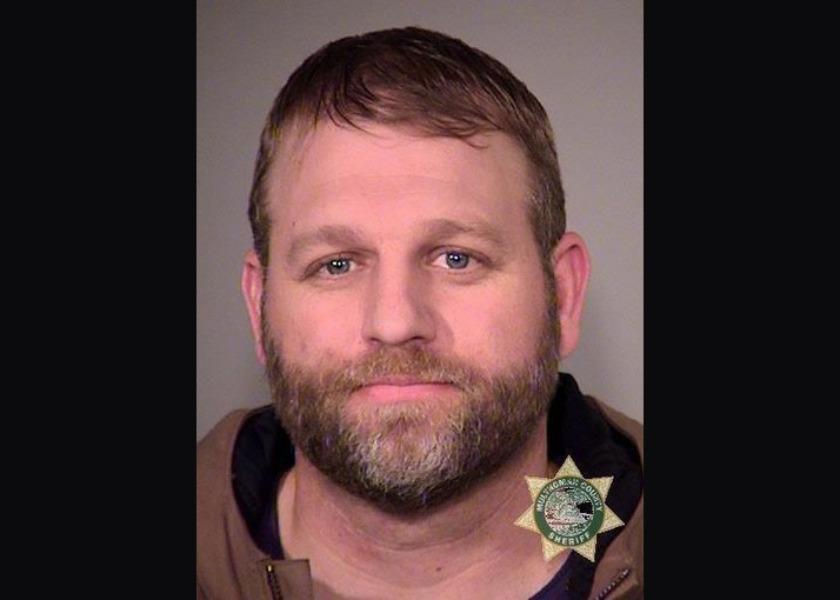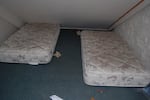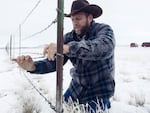
Ammon Bundy.
Courtesy of the Multnomah County Sheriff's Office
This story has been updated to reflect testimony heard by the jury regarding the cash Ammon Bundy was carrying when he was arrested.
The leader of the Malheur National Wildlife Refuge occupation had more than $8,000 in cash on him at the time of his arrest, according to testimony heard Tuesday in a Portland courtroom.
Ammon Bundy, one of seven people on trial in Portland in connection with the refuge takeover, also had two receipts when he was taken into custody: One was for a $6,000 cash withdrawal; the other was for a $200 purchase of ammunition, according to the prosecution. The prosecution said the ammunition receipt was dated Jan. 1 — one day before the occupation began.
Prosecutors said the cash showed Bundy planned to stay at the refuge for a long time. Bundy — along with Shawna Cox, Ryan Payne and other occupation leaders — was taken into custody Jan. 26 during a traffic stop.
Harney County Sheriff's Deputy Lucas McClain testified about how he transported Bundy, Cox and Payne after their arrest. Also in the transport van was 18-year-old Victoria Sharp, who was present when the others were taken into custody.
McClain said that after his arrest, Bundy — who was handcuffed — managed get a hold of a cellphone and make a call. McClain implied that Sharp, who was initially seated two rows behind Bundy but had subsequently moved to the seat next to him, had given him the phone. McClain said the call's implications were significant as Bundy could have been talking with other occupiers in an attempt to intercept the transport.
It is still unclear with whom Bundy was speaking, but his defense attorney, Marcus Mumford, implied Bundy was on the phone with his wife.
During McClain's cross-examination, Cox's standby counsel, Tiffany Harris, asked him if Sharp had moved seats because she had urinated during the ride.
Harris said McClain had denied Sharp the use of the bathroom for so long that she urinated in her seat, prompting the teenager to move next to Bundy.

The U.S. Fish and Wildlife Service has released photos of the occupation aftermath at Malheur National Wildlife Refuge.
U.S. Fish and Wildlife Service/Flickr
McClain’s testimony was preceded by that of two key refuge employees: the person responsible for managing refuge firefighting efforts and the man who runs the refuge’s grazing program.
Ryan Curtis runs the refuge’s firefighting program. Testifying for the prosecution, he talked about how different the refuge looked when he returned to it in February, after the 41-day takeover ended. Curtis said the old firehouse was filled with sleeping bags and mattresses that were not there before the occupation's start.
Prosecutors also asked Curtis to look at a series of photos of occupation leader, Ryan Bundy. Curtis said the photos showed his refuge office, with Bundy sitting at his desk. Curtis also identified his computer as the one David Fry was seen using in a video Fry uploaded to his website, Defend Our Base, during the occupation.
During Ryan Bundy’s cross-examination, he asked Curtis if he had lost any pay because of the occupation. “No,” Curtis said.

Ryan Bundy, one of the leaders of the armed militants who have taken over the Malheur National Wildlife Refuge, says his group has not accessed government computers on the site.
John Sepulvado / OPB
Ammon Bundy’s attorney, Marcus Mumford, asked Curtis if anyone had told him not to do his job during the occupation. The federal government has charged Bundy and other occupiers with participating in a conspiracy to prevent federal employees from working.
Curtis said he didn't go to work because of a call from his boss, the refuge manager.
Jess Wenick, an ecologist responsible for running the refuge grazing program for the U.S. Fish and Wildlife Service, also testified for the prosecution.
“I was born in Burns, Oregon, at the Burns hospital,” Wenick, a third-generation Harney County resident, told the jury.
Wenick, who has worked at the refuge for 13 years, was able to identify several occupiers as not being government employees in a video of them cutting a fence on the refuge boundary.
Prosecutors then showed the jury a video of Ammon Bundy, Jon Ritzheimer, Jason Patrick and Ryan Bundy removing about 100 feet of fence between the refuge and a nearby ranch.
Wenick, who has worked at the refuge for 13 years, confirmed that the fence in the video was on refuge property and that the people in the video were not government employees.

Ammon Bundy at a stretch of fence at the Malheur National Wildlife Refuge Monday, Jan. 11. The armed occupiers of the refuge took down an 80-foot stretch of the fence to open up the lands to cattle from a nearby ranch.
Anna King / Northwest News Network
Wenick was also able to identify his work truck in the video, as well as a piece of heavy machinery that he said belongs to the U.S. Fish & Wildlife Service. And in a photo of defendant Ken Medenbach, Wenick pointed out that the U.S. Fish & Wildlife Service symbol on the door had been covered. He testified that it was damaged in that process. The ecologist also was able to identify through photos an ATV assigned to him being ridden by several people armed with weapons. Wenick said they were not government employees.
He also said that some of his files are still missing from his office. Wenick also said that when one his employees returned to the refuge after the occupation, her office looked like a “technological sweatshop.” He said there was chewing tobacco spit on the walls and personal photos, several computers scattered about and a scanner in the office that didn’t belong to the refuge.
The court also learned that two jurors said that they saw defendant Neil Wampler on the MAX train Tuesday morning as they were heading into court. The jurors don’t think that he recognized them and it didn’t seem to be a larger issue, but Judge Anna Brown said it showed how diligent the jury is being about limiting its exposure to outside information about the trial.
The day wrapped up with testimony by the Oregon State Police patrol officer who arrested defendant Ken Medenbach and an FBI special agent who flew over the refuge during the occupation and captured video — footage that showed white trucks blocking the front and back gates to the refuge
The government said the case is moving much faster than they anticipated. They could rest as early as Monday or Tuesday.
Subscribe To 'This Land Is Our Land'
Subscribe to "This Land Is Our Land" on NPR One, Apple Podcasts or wherever you find your podcasts. Find comprehensive trial coverage at OPB.org/ThisLand.
Share your thoughts on the trial with us on Facebook and Twitter, or by emailing us directly at thisland@opb.org.